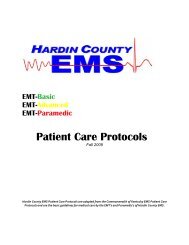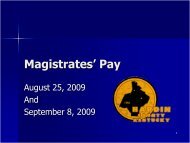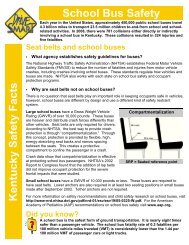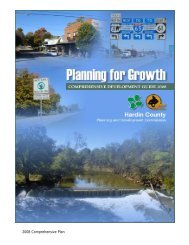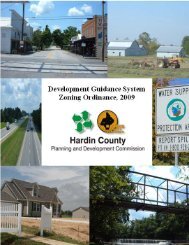?Vehicle Safety Checklist
?Vehicle Safety Checklist
?Vehicle Safety Checklist
You also want an ePaper? Increase the reach of your titles
YUMPU automatically turns print PDFs into web optimized ePapers that Google loves.
)ia!2aPTRANSPORTATION 1CABINETPlanning a summer vacation? Providing your vehicle is well maintained,getting it ready for a road trip is relatively quick and easy. Use this vehiclesafety checklist as a guide. Also, keep the emergency numbers given onthe back of this sheet. You never know when you might need a hand!I?<strong>Vehicle</strong> <strong>Safety</strong> <strong>Checklist</strong>erTire Tread: Check air pressure and tread wear on all tires, including the spare. Insert aLincoln penny into the tread of each tire. If you can see the entire top of his head, your treadis less than one-sixteenth of an inch deep and should be replaced.Tire Pressure: Make sure each tire is filled to the suggested PSI (pounds per square inch)CZI of air, which is listed in your owner's manual and on a label inside the driver's door. Checkwhen tires are "cold"-meaning they haven't been driven on for at least three hours.611 Belts and Hoses: Look under the hood and inspect all belts and hoses. Make sure thereare no signs of blisters, cracks, or cuts in the rubber. High summer temperatures acceleratethe rate at which rubber belts and hoses degrade.CZIWiper Blades: Check for wear-and-tear on both sides. After winter storms and spring rains,it's likely your windshield wiper blades are ragged from use and need to be replaced. Likebelts and hoses, wiper blades are susceptible to heat.CZIerCheck coolant level and get needed servicing. You want your coolingIsystem functioning properly to avoid the possiblility of your engine overheating.Air Conditioning: Make sure the air is cool. This is especially important if you are travelingwith people who are in poor health or sensitive to heat, such as children and seniors.Fluid Levels: Check oil, brake, transmission, power steering, and windshield fluid. Makesure each reservoir is full and there is no sign of leakage.Seatbelts: Make sure they are working properly. It's the law! Check for frayed webbing,which can weaken the fabric. Make sure all belts retract properly and inspect the metalhardware for cracks or damaged areas.Lights: Check headlights, brake lights, turn signals, emergency flashers, interior lights, andtrailer lights.Emergency Roadside Kit: Use the suggestions below to create your own.Cell phoneFirst aid kitFlashlightMapsJumpercablesFlares or white flagCar jack and ground mat for changing a tireWork gloves and a change of clothesBasic repair tools and some duct tapeExtra windshield washer fluidWater and paper towels for cleaning upNonperishable food, drinking water, and medicinesRemember to never leave children unattended in parked vehiclesespeciallyduring warm weather.
If You Are Involved In An IncidentKentucky has a Quick Clearance Law (KRS 189.580) meaning:If you are involved in a crash:If no one is visibly injured, move your vehicle to the shoulder or off the interstate or parkway-. Call policeExchange informationIf you have a disabled vehicle:Move vehicle off the roadway if possible and stay in the vehicleTurn on emergency flashersTie something white or bright to your antenna or window, or raise hood, to request aidIf unable to move the vehicle from the roadway, stand away from the vehicle.Need Help? The SAFE Patrol Is On It's Way!The SAFE (<strong>Safety</strong> Assistance for Freeway Emergencies) Patrol is currently operated Monday throughFriday between the hours of 5 am to 9 pm. on of 1-64 (milepoints 0-42 and 80-91), 1-65 (milepoints 17-59)and 1-75 (milepoints 0-62).To aid motorists, van drivers may provide gasoline and oil, add air to tires or change flat tires, provide a"jump" for dead batteries, and if necessary push vehicles off the roadway. Drivers also work to preventtraffic crashes by removing debris from the roadway and tagging abandoned cars. At the scene of a crash,drivers are trained in traffic flagging to assist in traffic management.The goal of the program is to continually increase the number of interstate segments served and increasethe program to a 2417 service.To request SAFE Patrol or report roadside emergencies, call 1-800-728-2448.For police assistance call 1-800-222-5555.Where Can I Find More Traffic & Travel Information?Call 511 if in Kentucky or 1-866-737-3767 if calling from out-of-state.Information can also be found at http:1/5ll.ky.gov.,*--*@TraJfic b Tra7!~I IH$~ror more information:AAA Exchange: http://www.aaapublicaffairs.comAAA Foundation for Traffic <strong>Safety</strong>: http:l/www.aaafoundation.orgAmerican College of Emergency Physicians: http://www.acep.org (Patients(National Highway Traffic <strong>Safety</strong> Administration: http://www.nhtsa.dot.govNational <strong>Safety</strong> Council: http://www.nsc.org/issues/drivsafe.htmRubber Manufacturer's Association: http://www.rma.orgpic)Kentucky Transportation CabinetDepartment of Transportation <strong>Safety</strong>highwaysafety. ky.gov1-888-374-8768



